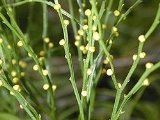
Psilotum nudum
Encyclopedia
Psilotum nudum is a fern
plant. Like the other species in the order Psilotales, it lacks roots. It is found in tropical Africa, Central America, tropical and subtropical North America, South America,, tropical Asia, Australia, Hawaii, southern Japan, Lord Howe Island, New Zealand, with a few isolated populations in SW Europe ("Los Alcornocales", Spain
, Cádiz
province).
Psilotum nudum, known as the Skeleton Fork Fern is considered a "primitive" plant - a descendent of possibly the first group of vascular plants which were widespread during the Devonian
and Silurian
periods. Its name, Psilotum nudum, means "bare naked" in Latin, because it lacks most of the organs of modern plants.
In tropical areas, this plant is often epiphytic, whilst in more temperate areas, such as south-eastern Australia, it is usually found growing in rock crevices. Thousands of people per day walk by these plants at the Sydney Opera House
forecourt.
(1603-1867).
The species is naturally found on all the main Hawaiian Islands. Known locally as Moa because of its chicken feet like stems, the Hawaiians collected large quantities of the spores and used them like talcum powder, under the loincloth to prevent chafing. The spores were also used medicinally as a purge. Children would play a game called ‘moa nahele’ or cock fighting with the branch stems. Twigs of the Moa were interlocked and the players pulled on the ends. The loser's twig broke and the winner crowed like a rooster. The species is still often used in making traditional Hawaiian leis.
Its common name, Whisk Fern, alludes to its use in the past as a small broom, made by tying a handful of its branches together. It is sometimes found in cultivation (either accidentally, as a weed in greenhouses, or deliberately, in the form of a number of cultivars).
It may prove to be a good source of antimicrobial chemicals.
Fern
A fern is any one of a group of about 12,000 species of plants belonging to the botanical group known as Pteridophyta. Unlike mosses, they have xylem and phloem . They have stems, leaves, and roots like other vascular plants...
plant. Like the other species in the order Psilotales, it lacks roots. It is found in tropical Africa, Central America, tropical and subtropical North America, South America,, tropical Asia, Australia, Hawaii, southern Japan, Lord Howe Island, New Zealand, with a few isolated populations in SW Europe ("Los Alcornocales", Spain
Spain
Spain , officially the Kingdom of Spain languages]] under the European Charter for Regional or Minority Languages. In each of these, Spain's official name is as follows:;;;;;;), is a country and member state of the European Union located in southwestern Europe on the Iberian Peninsula...
, Cádiz
Cádiz
Cadiz is a city and port in southwestern Spain. It is the capital of the homonymous province, one of eight which make up the autonomous community of Andalusia....
province).
Psilotum nudum, known as the Skeleton Fork Fern is considered a "primitive" plant - a descendent of possibly the first group of vascular plants which were widespread during the Devonian
Devonian
The Devonian is a geologic period and system of the Paleozoic Era spanning from the end of the Silurian Period, about 416.0 ± 2.8 Mya , to the beginning of the Carboniferous Period, about 359.2 ± 2.5 Mya...
and Silurian
Silurian
The Silurian is a geologic period and system that extends from the end of the Ordovician Period, about 443.7 ± 1.5 Mya , to the beginning of the Devonian Period, about 416.0 ± 2.8 Mya . As with other geologic periods, the rock beds that define the period's start and end are well identified, but the...
periods. Its name, Psilotum nudum, means "bare naked" in Latin, because it lacks most of the organs of modern plants.
In tropical areas, this plant is often epiphytic, whilst in more temperate areas, such as south-eastern Australia, it is usually found growing in rock crevices. Thousands of people per day walk by these plants at the Sydney Opera House
Sydney Opera House
The Sydney Opera House is a multi-venue performing arts centre in the Australian city of Sydney. It was conceived and largely built by Danish architect Jørn Utzon, finally opening in 1973 after a long gestation starting with his competition-winning design in 1957...
forecourt.
Cultivation and uses
The plant, which grows wild in southern Japan, was once much cultivated in Japanese gardens as an ornamental plant. Slightly over 100 garden varieties were given fantastic names. Called Matsubaran (pine needle orchid) in Japanese, it was one of the noble plants in the Edo PeriodEdo period
The , or , is a division of Japanese history which was ruled by the shoguns of the Tokugawa family, running from 1603 to 1868. The political entity of this period was the Tokugawa shogunate....
(1603-1867).
The species is naturally found on all the main Hawaiian Islands. Known locally as Moa because of its chicken feet like stems, the Hawaiians collected large quantities of the spores and used them like talcum powder, under the loincloth to prevent chafing. The spores were also used medicinally as a purge. Children would play a game called ‘moa nahele’ or cock fighting with the branch stems. Twigs of the Moa were interlocked and the players pulled on the ends. The loser's twig broke and the winner crowed like a rooster. The species is still often used in making traditional Hawaiian leis.
Its common name, Whisk Fern, alludes to its use in the past as a small broom, made by tying a handful of its branches together. It is sometimes found in cultivation (either accidentally, as a weed in greenhouses, or deliberately, in the form of a number of cultivars).
It may prove to be a good source of antimicrobial chemicals.

